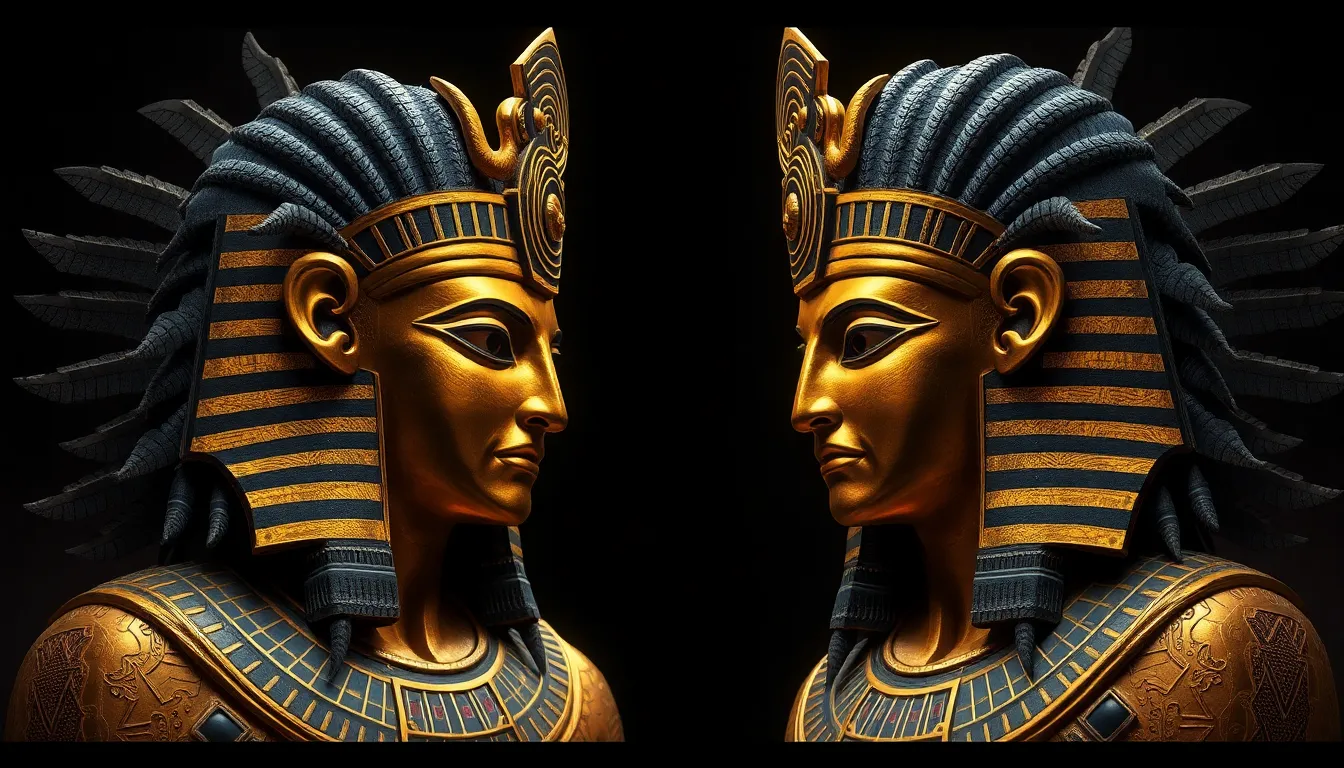The Divine Twins: The Myth of Osiris and Set
I. Introduction
Egyptian mythology is a rich tapestry of gods, goddesses, and beliefs that intricately weave the fabric of ancient Egyptian culture. Among the pantheon, two figures stand out due to their compelling narrative and the profound impact they had on Egyptian society: Osiris and Set. Their myth illustrates the fundamental themes of duality, conflict, and rebirth, highlighting the complexities of life and death in ancient Egyptian belief systems.
II. The Birth of Osiris and Set
Osiris and Set were born as divine twins to the sky goddess Nut and the earth god Geb. Their birth was not just a significant event in the divine realm but also symbolized the interconnectedness of various elements of the universe.
- Parentage: Geb and Nut represent the earth and sky, respectively, embodying the union of opposites.
- Significance: As twins, Osiris and Set exemplified the dual nature of existence—life and death, order and chaos.
While Osiris is often associated with harmony and fertility, Set embodies chaos and discord. This duality played a crucial role in the overarching narrative of their myth.
III. The Duality of Osiris and Set
Osiris and Set symbolize two distinct aspects of existence:
- Osiris: As the god of life, fertility, and the afterlife, Osiris represents growth, resurrection, and the cyclical nature of life. He is often depicted as a benevolent ruler who brings prosperity to the land of Egypt.
- Set: Conversely, Set is the god of chaos, desert, and storms. His tumultuous nature reflects the unpredictable aspects of life, such as natural disasters and conflicts. Set embodies the necessary challenges that foster growth and change.
This balance between Osiris and Set can be seen as a reflection of the natural world, where both life and chaos coexist, each playing a vital role in the cycle of existence.
IV. The Rivalry Between Osiris and Set
The rivalry between Osiris and Set is a central theme in their myth. It highlights the struggle for power and the consequences that arise from conflict.
- Power Struggle: Set, envious of Osiris’s popularity and divine authority, sought to usurp the throne of Egypt. This conflict represents the eternal struggle between good and evil.
- Role of Isis and Nephthys: The sisters of Osiris and Set, Isis and Nephthys, played crucial roles in the unfolding drama. Isis, devoted to her husband Osiris, sought to protect him, while Nephthys, married to Set, found herself torn between her loyalties.
Key events leading to Osiris’s demise include the infamous banquet where Set tricked Osiris into a coffin, which he then cast into the Nile, leading to Osiris’s death. This act of betrayal set the stage for the subsequent quest for resurrection.
V. The Death and Resurrection of Osiris
The narrative takes a dramatic turn with the murder of Osiris by Set, which serves as a pivotal moment in Egyptian mythology.
- Betrayal and Murder: Set’s jealousy culminated in the brutal killing of Osiris, an act that plunged the world into chaos.
- Isis’s Quest: Grief-stricken, Isis embarked on a perilous journey to locate her husband’s body. Her determination and love led her to the ends of the earth, highlighting the theme of devotion.
- Significance of Resurrection: Isis successfully resurrected Osiris, marking him as the god of the afterlife. This resurrection symbolizes hope, renewal, and the belief in life after death—a core aspect of ancient Egyptian religion.
VI. Set’s Role in the Myth and His Evolution
Set’s role as the antagonist in the myth is crucial, yet his character evolves over time.
- Depiction as Antagonist: Initially, Set is portrayed as a villain, representing chaos and disorder. His actions against Osiris establish him as the embodiment of evil.
- Cultural Perceptions: Over the centuries, Set’s image began to shift. In some narratives, he was viewed as a necessary force that maintained balance in the universe.
- Protector Role: In later interpretations, Set was sometimes regarded as a protector of the sun god Ra, symbolizing the complexity of his character.
VII. The Legacy of Osiris and Set in Egyptian Culture
The myth of Osiris and Set left an indelible mark on ancient Egyptian culture, influencing various aspects of society.
- Funerary Practices: The belief in Osiris’s resurrection influenced Egyptian funerary customs, emphasizing the importance of the afterlife.
- Art and Literature: Osiris and Set have been depicted in numerous artworks, tomb paintings, and religious texts, showcasing their significance in everyday life.
- Religious Thought: The themes of duality, conflict, and rebirth found in their myth continue to resonate in later religious philosophies.
VIII. Conclusion
The myth of Osiris and Set encapsulates the essence of ancient Egyptian beliefs concerning life, death, and rebirth. The dynamic between the two brothers reflects the universal themes of duality and conflict, illustrating how opposing forces shape existence. Their story not only served to explain the natural world but also provided a framework for understanding the complexities of human experiences. Even in modern interpretations of mythology, the legacy of Osiris and Set endures, reminding us of the timeless struggle between order and chaos, life and death.




